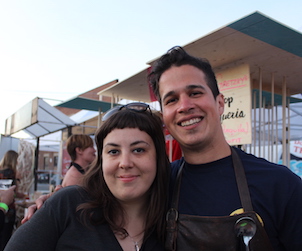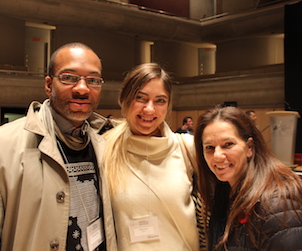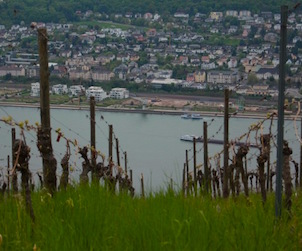by Anne Martin
As a wine writer, I am fortunate to receive invitations to various wine-related events, tastings and sometimes trips abroad to visit regions or attend trade fairs. Now, wine trade fairs in themselves can be a bit of a nightmare – badly organized, confusing, noisy and poorly laid out. But the Germans have got it right!
On a recent press trip , I was able to attend ProWein 2010 in Dusseldorf, Germany. I was a little apprehensive when I looked at the map of the show and saw how many airplane hangar-like buildings there were – seven in total. I entered the first one expecting to experience a wall of sound and frenetic activity. I found, instead, relative calm and beautifully displayed booths with wines from myriad countries that were easy to find, in groupings that made sense: all the eastern European countries were together, South America was easy to navigate and Germany had a pavilion to itself.
Since I was going to be touring the Mosel Valley directly after the show, I decided to focus on wines from more off-the-beaten-track places, wines that might never make it into the Ontario market. I also wanted to throw in a few top-quality German wines for good measure, to see what was being done across the country by the great producers. My fellow taster, Mariusz Kapczyński, a wine journalist from Poland, and I began at the VDP (Verband Deutscher Prädikatsweingüter) booth. This is the world’s oldest association of quality wine estates. Members are spread across Germany, all with rigorous standards, and it was a quick way to taste many great wines in one spot. We were able to try some wonderful samplings from Reichsgraf von Kesselstatt, Müller-Catoir, Reichsrat Von Buhl and J.B. Becker. From there we moved to Austria and tasted some delicious Grüner Veltliners from Schloss Gobelsburg. These were the perfect warm-up wines, because after lunch a group of us were invited to the “Union des Grands Crus de Bordeaux at ProWein.”
For the first time, the Bordelaise had decided to embrace the “increasing success of ProWein” and we were able to taste through many of the grand cru chateaux’s 2007 vintages. Quite a snooty affair, but a wonderful chance to see where the various houses were at. Things wrapped up with a few Sauternes for a suitably luxurious finish, which made me very happy.
From there I decided to venture to the more rustic side of wine-making and plunged into trying some wines from Georgia (the country), the “cradle of wine civilization.” This particular producer, called Pheasant’s Tears, ferments and ages their wines in traditional clay amphorae (qvevi). The grape names themselves sound like something from another world, ancient varietals like Saperavi, Shavkapito and Rkatsiteli. They are meant to be drunk with hearty foods, so tasting them on their own at the fair was a challenging experience because they have huge tannins, bracing acidity and are fairly oxidized. Not for the faint-hearted! I finished off day one with a couple of easy-drinking wines from Bierzo in northwestern Spain. The Mencia grape is a recent favourite of mine with its fresh, Cabernet Franc-like fruit.
On the second day, we decided to immerse ourselves in wines from “emerging regions/countries.” Uruguay was the first stop. I’d heard about the reds made from Tannat when I was last in London and was keen to try them. These wines were from a producer called Pisano and the tannins were very chewy, but they had good character. As it was right next door, we visited the Siam Winery from Thailand. Their Shiraz wasn’t bad – it boggles the mind as to how many new countries are making wine now. We moved back to South America and tried some Brazilian wines. One winery, located in the north of the country, has two and a half vintages per year! They are almost constantly harvesting grapes. Apparently, Brazilians love sparkling wine (maybe it’s better on the beach?) and there were a few examples to try. At this point, they still need some work, in my opinion.
We returned to the Old World and tasted through some Madeiras from the famous old house of Blandy’s. Located 1,000 kilometres off Europe’s Atlantic coast, this Portuguese island is renowned for its long-lived fortified wines. The variety of styles these wines are made in never ceases to impress me. We tried a delicious Malmsey Harvest 2001 amongst others. There was time for one final stop on the global wine tour and we chose a favourite region of mine – the Loire Valley in France. The producer was Champalou — a very small vineyard making outstanding wines. What a way to finish! The Chenin Blancs we tried illustrate the amazing ability of that grape to age well while still drinking beautifully now. These are the sort of wines that restore my faith in the business and help me remember why I decided to become a sommelier.
ProWein was a trip! It was a chance to taste the world under seven roofs and to identify current trends in the industry. The Germans are justifiably proud of the show and truly make an effort to be there themselves. Wisely, the rest of the planet is jumping on board too.
 Anne Martin is a Toronto-based sommelier, writer and wine consultant. Learn more about Anne, including her cellar and tasting services at www.annemartinwine.com.
Anne Martin is a Toronto-based sommelier, writer and wine consultant. Learn more about Anne, including her cellar and tasting services at www.annemartinwine.com.







